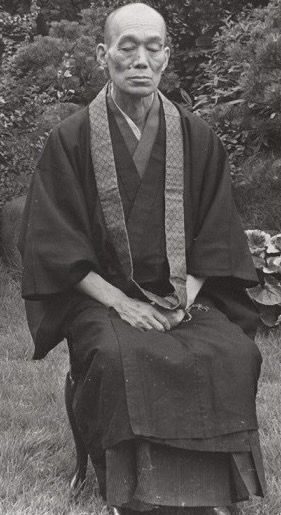
By Rev. Miki Nakura
When Shakyamuni Buddha attained enlightenment, he’s depicted as sitting in contemplation beneath the Bodhi tree. In that sense, we can say the Buddhist teachings sprung from meditation. The Buddha understood that body and mind are not separate but one, expressing non-dualism.
In our Jodo Shinshu tradition, practicing meditation is frowned upon and considered a futile attempt at gaining spiritual awakening through “self-power.” Instead, we are urged to rely on the “other power” of Amida Buddha.
For many years, I have sat daily in meditation. It helps me understand Jodo Shinshu and follow the Nenbutsu path. I do what’s called seiza (静坐) Japanese for “quiet sitting.” It refers to an easy form of meditation popularized by Okada Torajiro (岡田虎二郎 1872-1920). Okada-sensei greatly respected Shinran Shonin. Okada-sensei said, “Seiza nurtures faith constantly after awakening (Japanese: gogo no chōyo 悟後の長養).”
Other Jodo Shinshu followers also devotedly meditated in seiza, including notable Higashi Honganji and Nishi Honganji teachers such as Daiei Kaneko, Yoshikiyo Hachiya, Shūgaku Yamabe, Joen Ashikaga, Susumu Yamaguchi, and Sosuke Nishimoto.
Years ago, I asked a teacher of mine, Rev. Norimasa Hachiya: “Sensei, Jodo Shinshu is the teaching that focuses on Nenbustu alone. Why do you practice seiza so diligently?”
He replied: “Seiza cultivates in me a proper attitude to listen to the Buddha-dharma quietly without hakarai (a calculating mind). For Jodo Shinshu followers, this is most important.”
His father, Rev. Yoshikiyo Hachiya often said: “Without doing seiza, I cannot realize the Dharma.” At the Takakura lecture hall at Higashi Honganji headquarters in Kyoto, he’d encourage audience members to do seiza before his dharma talks. In that way, they’d cultivate a proper attitude for understanding Buddha-dharma through both body and mind.
Diligent daily seiza helps focus body and spirit on the hara, also called tanden (lower belly), considered in Japan and China to be the central location of a person’s spiritual and physical energy. For me, the hara is where one realizes “no hakarai” (mind of “no calculation). An “uncalculating mind” that’s free of preconceived notions is better able to listen to and perceive truth.
In that sense, I feel spontaneous Nenbutsu (reciting “Namu Amida Butsu”) is an expression of an uncalculating mind that quells the ego and allows one to enter the vast ocean of Buddha Wisdom. Daily practice of seiza helps nurture in me the Nembutsu life amid a turbulent world where my countless blind passions run amok. When “Namu Amida Butsu” spontaneously arises in my mind or out of my mouth, it naturally resonates from my hara.
Rennyo Shonin (1415-1499) is considered the second founder of Jodo Shinshu. In “The Sayings of Rennyo Shonin” (Japanese: Goichidaiki Kikigaki ), he tells of a devout follower named Dōshū:
“Although Dōshū listened to the teachings constantly, he listened as if hearing them for the first time and he was grateful.”
Rennyo commented: “Most men wish always to have something new and novel; but a person of faith feels everything is fresh and new, even if constantly repeated. Regardless of how many times, each is heard anew with open ears.”
To motivate and spur himself, Dōshū wrote down twenty-one resolutions. The first two say:
1: Throughout my entire life, stay alert to the Great Matter of rebirth (Japanese: gosho).
2: When thoughts other than Buddha-dharma enter deeply in my mind, consider it shameful and immediately turn them around.
According to Rennyo, “If one entrusts in Amida, one’s entire body is wrapped in Namu Amida Butsu.” This means a true Nenbutsu follower is filled with gratitude and joy.
Morimoto Shonen-roshi was a close Dharma friend of Buddhist teacher Hachiya Yoshikiyo sensei. Morimoto was a Rinzai Buddhist master, who was greatly respected by the great Buddhist scholar D.T. Suzuki. Morimoto and Hisamatsu Shin’ichi were disciples of Nishida Kitaro (1870-1945), a renown philosopher.
In a letter, Morimoto-roshi wrote:
When we first consider Jodo-shu or Jodo Shinshu, they seem like schools of the “Easy Path.” Actually it’s quite difficult to have faith (Japanese: shinjin). Rennyo Shonin praised the devout follower Dōshū for having “consistently maintaining right faith” (Japanese: shōnen-sozoku 正念相続). He was none other than a devoted practitioner of seiza. Seiza is the form and attitude of “consistently maintaining right faith.” Seiza itself is shōnen-sozoku… because it is not one’s own practice, but rather, the meditation of Shakyamuni and other Buddhas in the ten directions, past, present and future.
Like Dōshū, a person who truly has faith (Japanese: shinjin) consistently maintains a mind of right faith. Many follow the “easy path” of Jodo Shinshu, but few become like Dōshū. I think this type of realization is cultivated best by “sitting,” rather than by reading books or listening to others.
I believe all Buddhist teachings sprung from zazen (sitting meditation) by the Buddhas. The same for Amida Buddha’s great Vow (Japanese: hongan), the essence of Jodo Shinshu. Zazen is a vital force that penetrates all and personally it manifests itself in seiza.
Sitting beneath the Bodhi tree, sitting calmly in meditation, Siddhārtha attained enlightenment. On Mt. Hiei in a Tendai Buddhist monastery, Shinran Shonin practiced shikan meditation (Sanskrit: samatha “quietness” and vipasyana “insight”), which I believe helped him naturally nurture the power and energy of the hara (belly). With this spiritual foundation, he was able to understand the words of his teacher Honen, “Just recite the Nenbutsu” with no hakarai. That’s why each and every day, I do seiza.
A Short Guide to Seiza
We sit on a floor cushion or in a chair while maintaining proper posture, breathing, and putting full energy into the lower belly.
- Firmly erect lower back to maintain a natural, gravity-aligned posture.
- Exhale slowly and as long as possible through your nose.
- Put your full energy into the lower belly while breathing out.
-Rev. Nakura is minister of Jodo-Shinshu Shin Buddhist New York Sangha
Other stories about Jōdo Shinshū and meditation:

